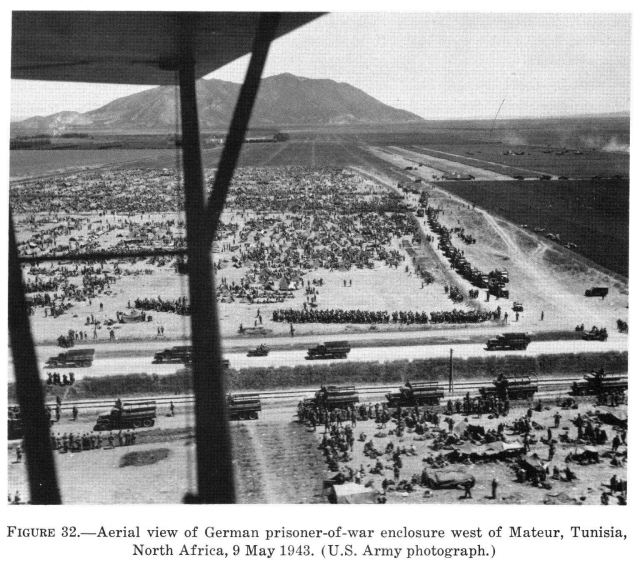Your right Joe, PWs were the bane of the combat troops.There are several reports of Division MPs escorting PWs from the front lines, ofton going back with the wounded, being captured by a german patrol. Sometimes they were recaptured by our guys, sometimes not.
By the end of the war, there were over 200,000 men in the Corp of Military Police and it still wasnt enough to handle the masses of PWs & "disarmed personel", Most of whom ended up in the 16 large enclosures built along the Rhine,originaly built to hold20,000=40,000 it wasnt unusal for the enclosures to have 60,000-100,000 jammed into them.
My dad was stationed at the enclosure near Bretzenhiem at the end of the war and absolutely refused to ever speak of the place. I cannot even begin to imagine how nasty the place was.
The Allies had the same problems with masses of POWs at the end of the North African campaign in Tunisia.
Prisoner-of-war enclosure at Mateur.—The most famous, and notorious, prisoner-of-war enclosure in northern Tunisia was located just north of Mateur (captured on 3 May 1943) on the farmyard plain at the foot of Djebel Achkel. A photograph (fig. 32) of the crowding there on the unsheltered sand on 9 May is more expressive than many words. These men were a large portion of the 275,000 prisoners that were captured by the Allies in the last week of the fighting in Tunisia.
In spite of the overflow of defeated Axis soldiers, some efforts at preventive medicine were made, even in the teeming barbed wire enclosure at Mateur. General Bradley, who watched the scene unfold, wrote, as follows:
* * * We anticipated 12,000 or 14,000 PWs. By nightfall, however, the Germans had overrun our cages. German engineers were conscripted under their own noncoms to expand the enclosure. We doubled and soon tripled that original compound.
For two days, as far as one could see, a strange procession of PWs trailed up the road from Mateur as though on a holiday junket.
Some came in long convoys of GMC's guarded only by an occasional MP atop each cab with a rifle. [As in the European theater, most of the prisoners were so docile that they did not need guards, but guides to the enclosures.] Others traveled in giant sand-colored Wehrmacht trucks bearing the palm-tree markings of the Africa Korps. On bicycles, farm carts, motorcycles, gun carriages, even burros, they trailed contentedly toward the cages. By the time this flow thinned down we had counted 40,000.
When General Eisenhower saw something of the handling of hordes of enemy prisoners of war in the European theater in 1945, he recalled “the time in Tunisia when the sudden capture of 275,000 Axis prisoners caused me rather ruefully to remark to my operations officers, Rooks and Nevins:
‘Why didn’t some staff college ever tell us what to do with a quarter of a million prisoners so located at the end of a rickety railroad that it's impossible to move them and where guarding and feeding them are so difficult.




